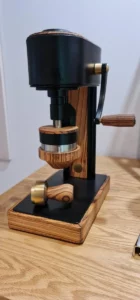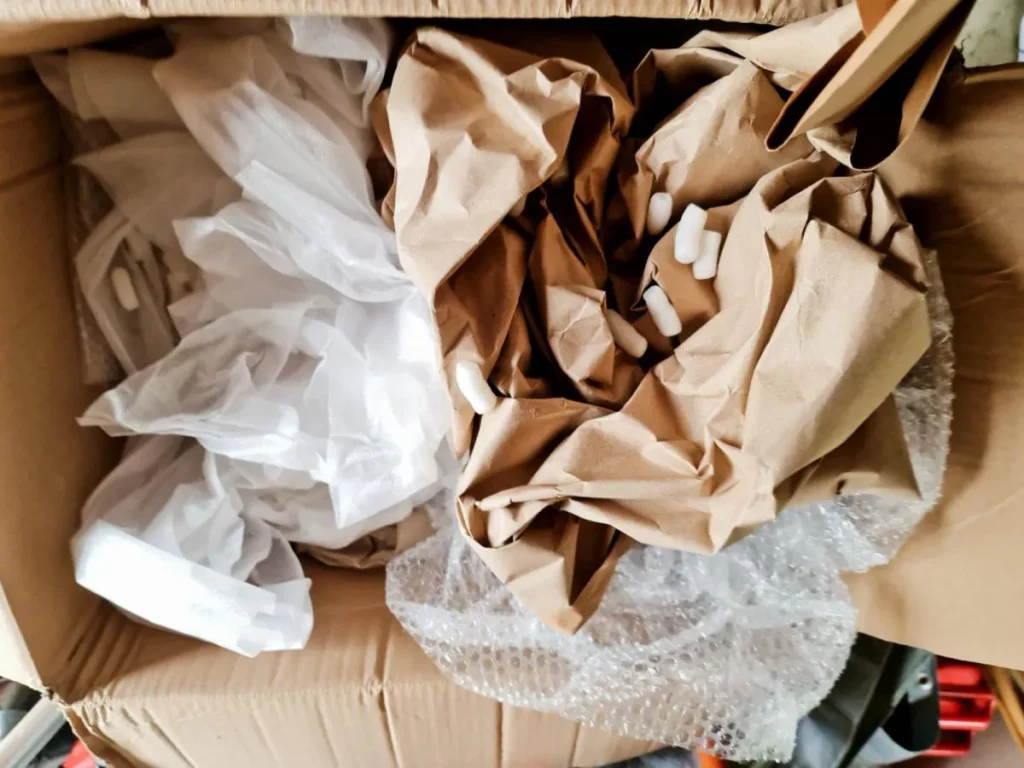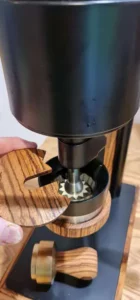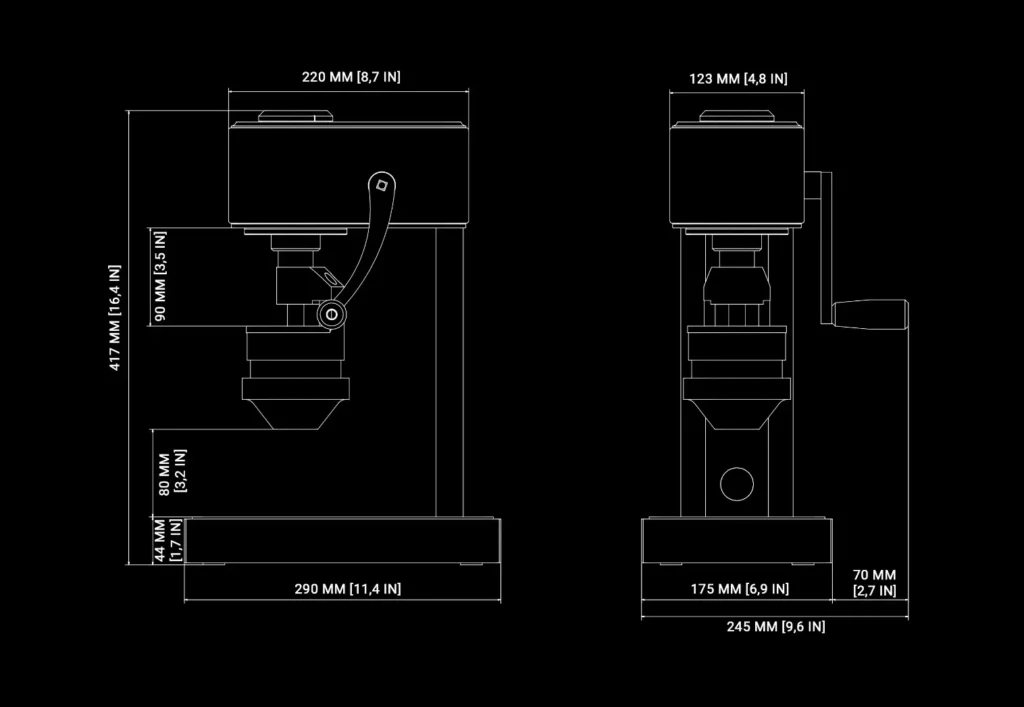Click on any thumbnail to access the full written review of any particular grinder.
Send review request to tom@tomsgrinderlab.com

Malwani Livi Benchtop Hand Grinder Review
First looks December 2022

Here is a list of sections – just skip to the part you want to read.
- THE MALWANI LIVI EXECUTIVE SUMMARY
- THE BACKGROUND
- UNBOXING AND FIRST IMPRESSIONS
- WORKFLOW
- WORKFLOW
- IN THE CUP / BEST ROAST DEPTH SUITED FOR
- SPECIAL FEATURES / CHARACTERISTICS
- COMPARISON TO THE NICHE ZERO AND HEDONE HONNE
- WHAT I DON’T LIKE
- WHAT I LIKE MOST
- VALUE FOR MONEY
- VALUE FOR MONEY
- MANUFACTURERS RIGHT OF REPLY
I thought it might be fun to try a bench top hand grinder and whilst I love the smooth functionality of a Weber HG-2 and Lynn’s HG-1 Prime, I don’t like the looks of them.
During a web search I stumbled onto the Malwani website and it was love at first sight.
I placed an order almost immediately, not realizing that Covid delays would mean an eight month wait. But it was worth it. The Malwani Livi arrived onto my benchtop in May of 2022 and I’ve used it most days since, which means that it’s had a good six months of use.
I bought the black powder coated model with zebrano timber and I immediately swapped out the stock Italmill burrs for Mazzer Robur burrs.
I paid full price for the Livi and I am not receiving remuneration or other inducement from Malwani for writing this review which I write exclusively for the Coffee Snobs and Coffee Time communities, each of whom have given me so much on my espresso journey.
Right of Reply
This review features the manufacturer’s “Right of Reply” at the end. Please read their reply to balance up my views. I may have missed something important, or I may have got something wrong.
I’d read some horror stories about the inadequate packing on the Livi which consisted of loose straw and screwed up sheets of newspaper, all plonked in a cardboard box. A recipe for disaster and indeed, there have been a few.
I stressed the importance of improved packing when I ordered my Livi from Valentin Muckle (Founder and Owner of Malwani) and it was improved somewhat with the straw and newspaper being replaced with foam sheets, plastic bubble wrap and small styrofoam cylinders.
But the packing still needs urgent attention in the form of a professionally designed, custom cut foam mold that not only holds the Livi in place securely but also fits snugly in a double skinned box so that when it is dropped, which it will be, there is no damage to the grinder. Malwani has a long way to go before it’s up the standards of Weber or Niche or Olympia however it’s an easy fix.
The grinder arrived perfectly aligned.
You don’t buy a hand grinder for workflow. That said, the workflow is pretty good. You’ll get the odd splinter or coffee bean jumping out of the hopper but it’s only a small splinter here and there and sometimes none.
If you use the Mazzer Robur burrs and a reasonably swift grinding action then you’ll grind rate will be around one gram per second.
Miniscule, due to the design. No housing or casing between the feed bucket and the catch cup.
It’s worth mentioning again that I swapped the standard Italmill burrs that the Livi comes with for Mazzer Robur burrs which are a big improvement on two counts.
Firstly, the flavor is stronger and secondly the grind time shrunk from 40 seconds to 15 seconds.
Hand crafted in a small workshop in Freiberg am Neckar, around 30 minutes drive north of Stuttgart and 30 minutes south of where my wife was born.
Amazingly, the Livi comes with a lifetime guarantee, other than for user-inflicted cosmetic damage and normal wear to the burrs. That is very rare and speaks volumes for the faith that Valentin has in the quality of both his design and build.
The Livi features a three to one gear ratio making grinder relatively easy.
The hand crafted timber catch basket is a beautiful piece of craft work on it’s own and the grinds slip off it easily with very few particles left behind.
The grind dial is another piece of craftmanship. Ornate, intricate and beautifully designed.
Only local timbers are used in the making of each grinder, which may explain why my Zebrano timber version seems to have been discontinued.
The Livi features variable RPM (😊).
Remember that I’m using Mazzer Robur burrs in the Livi which are the same burrs that you’ll find in the Craig Lynn’s excellent EG-1 Prime, the Weber EG-2 (both benchtop hand grinders) and the Weber Key grinder.
I ground an 18 gram dose of Medium roasted Kenya AA Lena beans from each grinder and then poured each dose back to back using the Adaptive profile on the Decent DE1XL. Each pour was in the 25 – 30 second range.
Once I had poured both shots, I sampled each espresso back to back, washing my mouth out with a little water before the first cup and in between each cup.
I repeated that three times on day one for the Livi and Niche and on day two for the Livi and Honne.
Day one: Livi versus Niche
The espresso from the Niche was thicker, which is another way of saying it had more body.
The Livi produces more clarity and more sweetness, and the texture was silkier and the flavors more subtle, with what I would call more “nutty origin” notes.
There is no doubt that the Livi produces slightly thinner espresso, and my guess is that is because there are less fines produced by the Robur burrs than the Kony burrs.
That’s not a good thing or a bad thing, it’s just a different thing.
In summary, if you like espresso that is thicker in body and more chocolatey in flavor, then go with the Niche. I think that applies doubly if you like adding milk.
And if you want to explore on the lighter side of medium roast beans, you’ll either want the Robur burrs or a flat burr grinder.
Day two: Livi versus Niche
The packaging. I’ve covered this in the section on Unboxing.
The seasoning required. The Livi was like the Honne in that they both needed at least 2 kilos of beans through them before I got any sense out of the dials. Before that, a slight adjustment could produce a massive difference, or a big adjustment could produce very little difference. In short, there was no predictability of consistency until the burrs had a couple of kilos of beans through them. Which is not easy to do with a hand grinder!
Customer support. Can be iffy sometimes. But for me, it was worth having to chase queries up with Valentin because I’m a sucker for beauty. To his credit, Valentin was always responsive, eventually. And he was generous and helpful. It’s just that my experience would have been smoother if the response was more Decent-Espresso like.
The Manual. There is none. To be fair, it’s a simple grinder. But still, I would have liked a diagrammatic instruction for swapping the burrs out. As it was, Valentin helped me out with what to do and I was relieved to discover that it was super easy to remove the original burrs and replace them, perfectly aligned. Whew.
The precision of the CNC machining, the generously thick stainless steel, the brass, the timber, the design, the hand crafted feel, the beauty, the simplicity of design and the quality.
Also, the experience of using a manual hand grinder. The Livi pairs so well with the Strietman CT2 in that they are both minimalist machines, hand crafted and win me over with the literal sensuality of using each one.
The most obvious comparisons to the Livi are the HG-1 Prime and the HG-2 and both of these machines are well-designed, well-engineered, high quality products.
The HG-1 Prime is around US$1,000 and the HG-2 is around US$1,650.
As a stock item, the Livi is approximately US$1,500 but when you add US$150 for a new set of Mazzer Robur burrs then the Livi is almost exactly the same price as the HG-2.
The HG-2 is smoother to use but the Livi is easy enough, it just doesn’t “glide” quite the same way as the former does..
Given that the espresso for these three grinders (and the Weber Key) are going to be indistinguishable from each other, it may come down to looks for you.
Personally, I really don’t like the look of the HG-2.
I do however like the look of the HG-1 Prime and it comes with a price advantage.
But I fell in love with the Livi’s looks and today I’d still choose the Livi over the others.
The Livi is a thing of beauty. Put together by hand and made from local German components. If you want to derive joy every time you look at your espresso bench and you value the idea of a slower and more physical experience, then the Livi is a winner. Add the massive Robur conical burrs and you have espresso that’s right up there with the best of any conical grinder, electric or manual.
We have adjusted our packaging. The LIVI now comes in a wooden box and is padded with lots of wood wool and packed in a cloth bag. We would like to avoid using plastic in the packaging. The wooden box is also packed in a double-walled cardboard box. Similar to a good wine, the LIVI now comes well protected and we also think that the unpacking experience is really good. An instruction manual is now also included, although the LIVI is self-explanatory as described.




